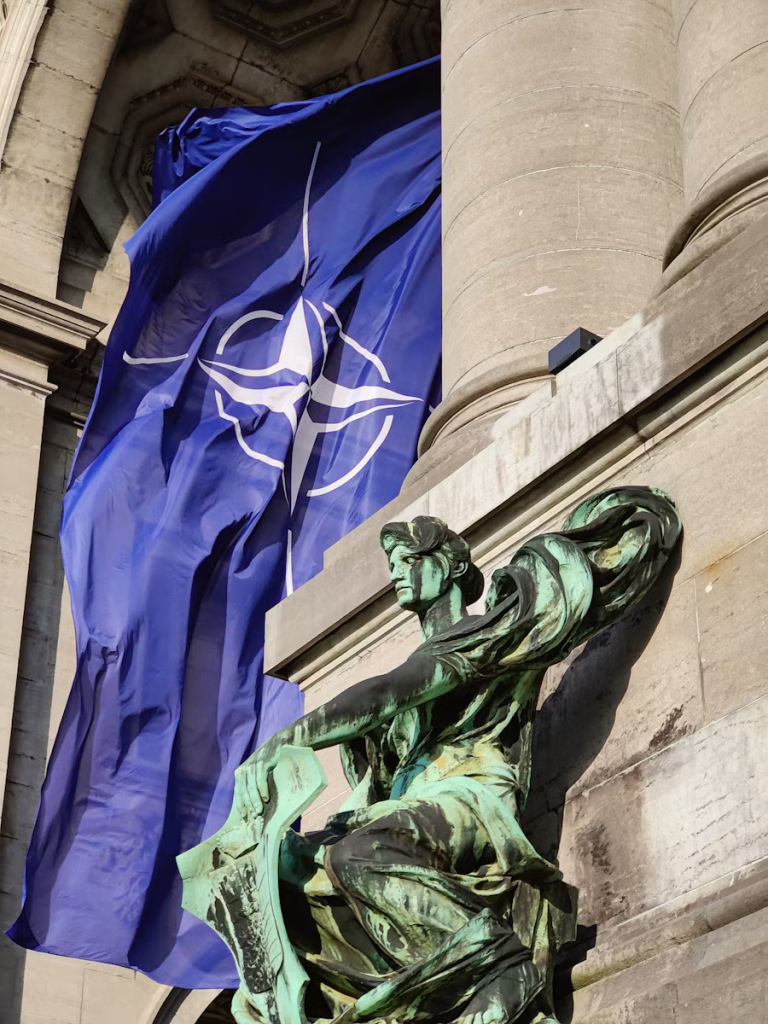Escalation Risks in Eastern Europe and the Shadow of World War III
Written by Elisa Garbil – 18.09.2025
The geopolitical temperature in Eastern Europe has been rising sharply. In recent weeks, Poland has found itself at the forefront of a dangerous escalation between NATO and Russia. Russian drones have repeatedly intruded into Polish airspace, testing both Poland’s defensive capabilities and NATO’s collective resolve. Warsaw has responded decisively, scrambling jets, closing borders with Belarus, and pledging significant military upgrades. Yet these actions, while defensive in nature, carry profound risks of further confrontation. With Russia and Belarus conducting massive Zapad military exercises near NATO’s eastern flank, the potential for miscalculation or deliberate provocation has never been higher. The stage is being set for a volatile confrontation where any spark could ignite a wider conflict.
The Drone Incursions: Testing Boundaries
Poland’s recent experience with Russian drones underscores a dangerous new chapter in hybrid warfare. These drones, sometimes carrying explosives, have crossed into Polish airspace multiple times, triggering air raid alerts and forcing the Polish military to shoot them down. For Poland, a NATO member, such violations are not mere irritations: they represent breaches of sovereignty that could activate collective defense obligations under Article 5 of the NATO treaty.
Moscow’s strategy appears to be probing NATO’s responses, gauging both speed and willingness to act. Drone incursions provide plausible deniability, allowing Russia to escalate without formally declaring hostilities. Yet for Poland, every intrusion carries the risk of civilian casualties, infrastructure damage, or accidental escalation with NATO forces. The risk calculation is stark: if one drone were to kill civilians on Polish soil, the pressure for NATO to respond militarily would be immense, setting a dangerous precedent for confrontation.
Zapad Exercises: A Dangerous Display
Compounding these drone incidents is Russia’s decision to stage large-scale Zapad military drills with Belarus, directly adjacent to NATO’s eastern flank. These exercises, framed as routine defensive maneuvers, are anything but benign. In practice, they involve tens of thousands of troops, advanced weaponry, and the simulation of large-scale offensive operations.
For NATO, the Zapad drills are viewed as a thinly veiled rehearsal for potential aggression against neighbouring states. Poland, Latvia, Lithuania, and other frontline NATO members see these exercises as dry runs for invasion scenarios. The exercises also serve as intimidation tools, signaling Russia’s readiness to escalate at will. In such a climate, even a minor incident, such as a misfired missile, a drone crash, or a border skirmish, could trigger rapid escalation.
Poland’s Response: Militarisation and Preparedness
Faced with mounting threats, Poland has responded by hardening its defenses. Prime Minister Donald Tusk has vowed to accelerate military modernisation, including investments in air defense systems, advanced drones, and upgraded surveillance capabilities. Poland has also taken the extraordinary step of closing its border with Belarus, citing security risks from Russian-led exercises and hybrid threats.
While these moves strengthen Poland’s security posture, they also carry risks of further inflaming tensions. Closing borders disrupts civilian and commercial traffic, fueling resentment in Minsk and Moscow. Military upgrades, while defensive, are perceived by Russia as aggressive preparations. Each step Poland takes to secure itself risks being mirrored by an escalation from the Russian side, creating a dangerous spiral of action and reaction.
NATO on Edge
NATO, too, finds itself in a precarious position. Alliance members have expressed solidarity with Poland, with air patrols stepped up and intelligence-sharing intensified. Yet NATO’s dilemma is profound: too little response invites further Russian provocations, while too strong a response risks confrontation. The alliance must walk a narrow line between deterrence and escalation.
The very structure of NATO, built around the principle of collective defense, magnifies the stakes. A Russian drone incident that causes casualties in Poland could obligate all NATO members, from the United States to smaller European allies, to respond militarily. Thus, what begins as localised provocations along Poland’s border could draw the world into a broader war.

Belarus as a Launchpad
Belarus plays a central role in the unfolding crisis. By hosting Russian forces and allowing its territory to serve as a staging ground for exercises and incursions, Belarus acts as both participant and proxy. The Zapad drills highlight the integration of Belarusian and Russian militaries, effectively erasing distinctions between them in practice.
For NATO, this creates a two-front risk: Poland faces threats not only from Russia directly but also from Belarusian territory. Border closures and heightened security are necessary defensive steps, yet they contribute to the growing sense of isolation and hostility in the region. Belarus, by aligning itself so closely with Moscow, has tied its fate to Russia’s strategic gambles, making it both a partner and a pawn in the wider geopolitical contest.
Escalation Scenarios: How Sparks Could Ignite
Several plausible scenarios illustrate how the current situation could escalate into something far larger:
- Drone Miscalculation: A Russian drone strike inadvertently kills civilians in Poland. NATO is pressured to retaliate, leading to Russian countermeasures.
- Border Skirmish: During Zapad drills, Russian or Belarusian forces accidentally or deliberately cross into Polish territory. Even a small clash could escalate quickly given NATO’s defense commitments.
- Cyber and Hybrid Attacks: Russia escalates its use of hybrid warfare: cyberattacks on Polish infrastructure, sabotage, or disinformation campaigns that provoke retaliation from NATO.
- False Flag Operations: Either side could misinterpret or manipulate an incident, blaming the other and justifying military escalation.
- Chain Reaction: An initial confrontation in Poland drags in NATO allies, expanding the conflict across Eastern Europe and potentially into a global confrontation between nuclear powers.
Risk Assessment: Likelihood and Severity
| Escalation Scenario | Likelihood | Severity | Overall Risk |
| Drone Miscalculation | High: incursions are already frequent, and a deadly incident is increasingly likely | High: civilian deaths in NATO territory would force a strong response | High |
| Border Skirmish | Medium: Zapad drills increase chances of accidental contact, but deliberate invasion is less likely now | Very High: even a small clash could trigger Article 5 | High |
| Cyber and Hybrid Attacks | High: Russia has already used cyber tools extensively and can escalate at low cost | Medium: disruptive but less likely to trigger NATO military action | Medium |
| False Flag Operations | Medium: Russia has a history of manipulation, but evidence requirements are higher under NATO scrutiny | High: could justify rapid escalation on either side | Medium–High |
| Chain Reaction / Wider War | Low–Medium: requires multiple triggers, but the pathway exists if escalation spirals | Catastrophic: global war, nuclear risks, systemic collapse | High (due to severity) |
This assessment highlights the dual nature of the risks. Some scenarios, such as drone miscalculations and border skirmishes, carry both high likelihood and high severity, making them particularly dangerous. Others, such as chain reactions, may seem less probable but are so catastrophic in consequence that they remain among the most alarming.
The Nuclear Shadow
Underlying all these risks is the specter of nuclear escalation. Russia’s military doctrine explicitly allows for the use of tactical nuclear weapons in scenarios where its security is threatened. NATO, too, maintains nuclear capabilities as part of its deterrence posture. The danger lies not only in deliberate use but in miscalculation. A conventional clash that spirals out of control could cross thresholds faster than either side intends, especially under the fog of war. The global consequences of such escalation are catastrophic, raising the stakes of every drone incursion and every military drill.
Poland’s Vulnerabilities
Despite its determination, Poland faces structural vulnerabilities. Reports suggest gaps in its military modernisation drive, with procurement delays, training shortfalls, and logistical challenges. These weaknesses could embolden Russia to continue probing, calculating that Poland is not yet ready for sustained confrontation. Such vulnerabilities also increase the pressure on NATO allies to step in, further internationalising the conflict.
Poland’s position as a frontline state magnifies the risks. Unlike more distant NATO members, it has little buffer against aggression. Every violation of its airspace or border has immediate consequences, forcing Warsaw into rapid responses that leave little room for diplomatic maneuver.
The Wider European Risk
The crisis in Poland is not isolated. Across Europe, fears of escalation are mounting. The Baltic states watch with alarm as Russian and Belarusian forces conduct drills near their borders. Germany, France, and the UK face domestic debates about their level of commitment should Article 5 be triggered. Meanwhile, Ukraine remains locked in a grinding war of attrition, serving as both backdrop and catalyst for the current tensions.
If Poland were drawn into direct conflict, Europe as a whole would be plunged into crisis. Energy markets would collapse, refugee flows would surge, and the continent’s fragile political consensus would fracture. Russia, for its part, may be betting on precisely this fragmentation, hoping that the fear of war will paralyse NATO and prevent a united response.

Global Implications
The risks extend beyond Europe. The United States, as NATO’s cornerstone, would be forced into a confrontation with Russia if Article 5 were invoked. Such a conflict would reverberate across the globe, drawing in allies and adversaries alike. China, Iran, and other powers would seize opportunities to advance their agendas amid the chaos, potentially expanding the conflict into new theaters.
Global markets would spiral into turmoil, with food, energy, and security crises spreading rapidly. The interconnected nature of today’s world means that a clash in Eastern Europe could destabilise far-flung regions, from the Middle East to the Indo-Pacific.
Walking the Razor’s Edge
Ultimately, the current situation highlights the razor’s edge on which the world is balanced. Russia’s drone incursions into Poland are not random provocations but calculated moves within a broader strategy of intimidation and escalation. Poland’s defensive responses, though necessary, escalate the spiral. NATO’s deterrence posture, while vital, risks being tested to the point of rupture.
The danger of World War III is not abstract: it lies in the accumulation of small incidents, miscalculations, and deliberate provocations that can combine into an uncontrollable cascade. The crisis on NATO’s eastern flank serves as a stark reminder that peace is fragile, and the line between local conflict and global catastrophe is perilously thin.
A Precarious Future
The Polish border crisis, fueled by Russian drones and amplified by the Zapad drills, is more than a regional security issue: it is a flashpoint with global consequences. Each intrusion into Polish airspace, each military maneuver on Belarusian soil, and each NATO response carries risks of escalation that could spiral beyond control.
The path forward is fraught with peril. Diplomacy remains essential, but so too does credible deterrence. Poland and NATO must remain vigilant, yet measured, resisting the trap of overreaction while preparing for the worst. For Russia, the strategy of provocation may yield short-term gains, but it risks unleashing forces beyond its control.






One Comment
Comments are closed.